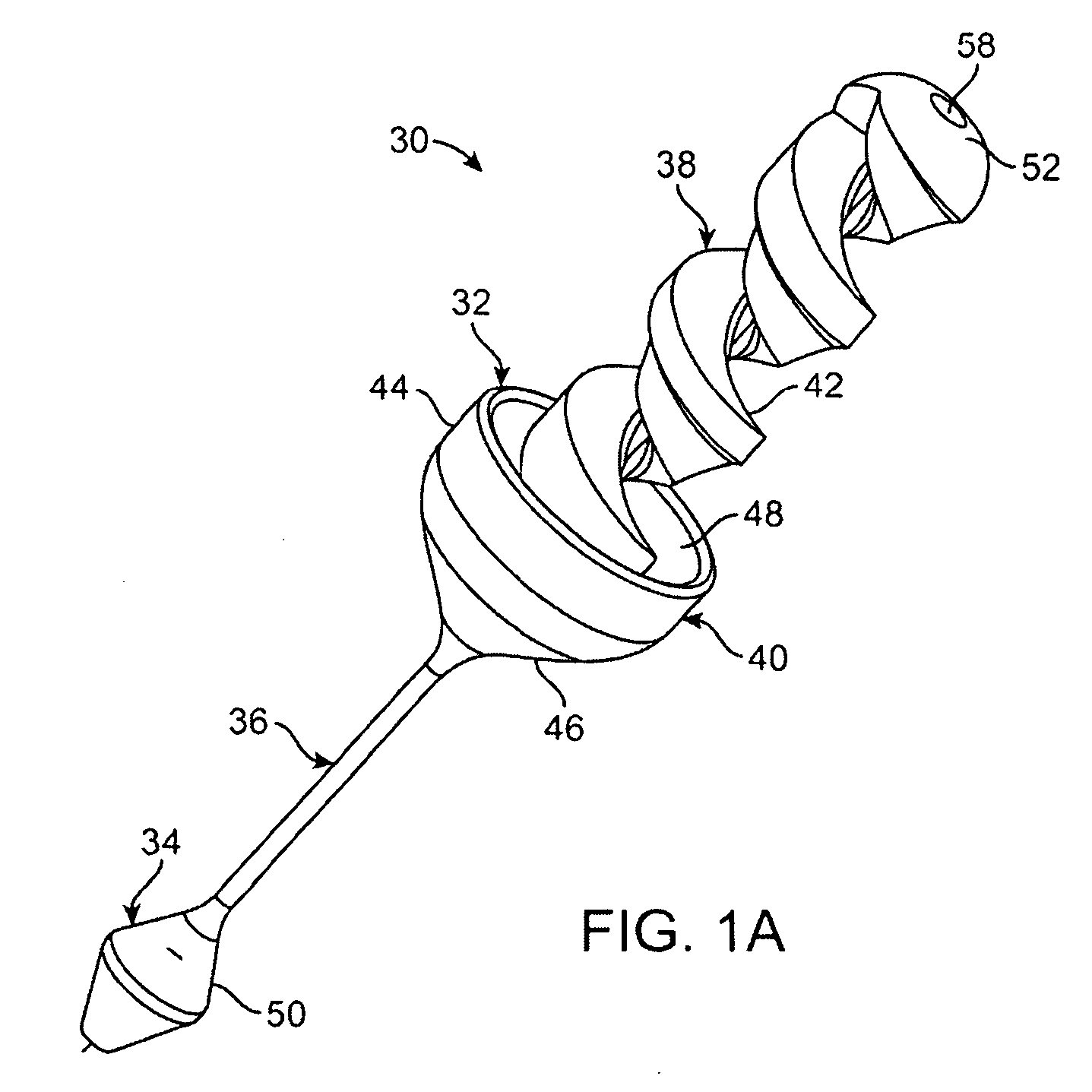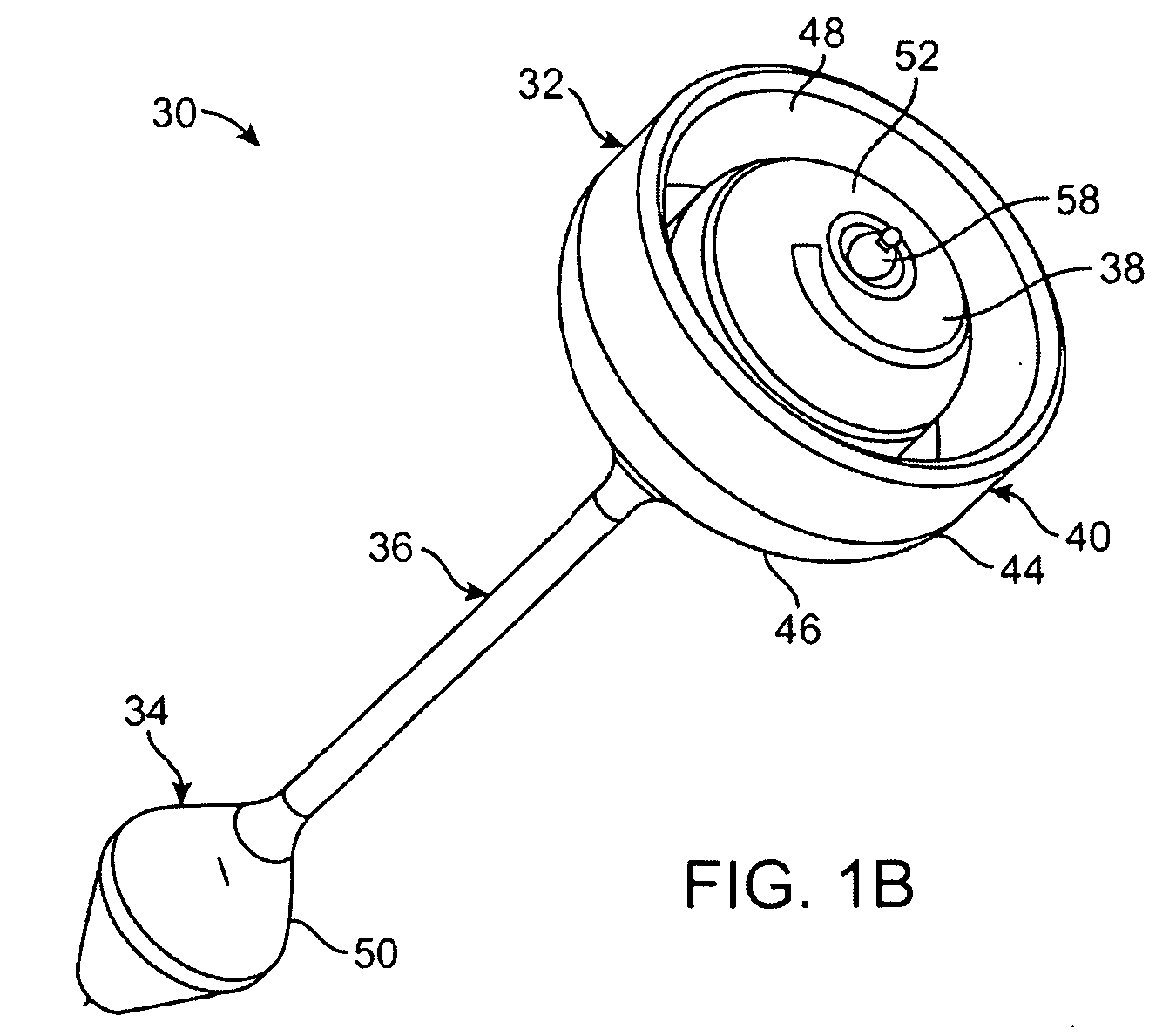Device for intermittently obstructing a gastric opening and method of use
a technology of obstructing and gastric opening, which is applied in the field of gastrointestinal devices, can solve the problems of weight loss, increased or sustained feeling of fullness, etc., and achieve the effects of reducing the overall gastrointestinal transit, reducing the flow of gastric contents, and being safe and relatively simple to perform
- Summary
- Abstract
- Description
- Claims
- Application Information
AI Technical Summary
Benefits of technology
Problems solved by technology
Method used
Image
Examples
first embodiment
[0060]FIG. 1A depicts the invention, which is configured for insertion into a patient's organ, typically the stomach. Device 30 includes a proximal member 32 and a distal member 34, which are connected one to the other by a tether 36. The relative sizes of proximal member 32 and of distal member 24 are such that, after insertion into the stomach of a patient, the natural contractions of the stomach and, in general, the movements of the patient induce distal member 34 to enter the pyloric part of the gastro-intestinal tract and the duodenum, while proximal member 32 is retained in the stomach and cannot move beyond the pyloric valve because its diameter is larger than the pyloric valve opening.
[0061]More particularly, proximal member 32 includes a first occluding member 38, disposed in a central position within an apron member 40. First occluding member 38 may be formed from an elongated, narrower configuration as shown in FIG. 1A to a contracted, wider configuration as shown in FIG....
embodiment 30
[0089]FIG. 5 illustrates the elongated, narrower configuration of device 68 prior to introduction in the stomach or other organ of a patient. In this elongated, narrower configuration, device 68 has apron member 74 oriented distally (towards the second occluding member), which requires that apron member 74 be reversed to change orientation and to become directed proximally, as shown in FIG. 5 and as described in relation to embodiment 30. Alternatively, apron member 74 may be oriented proximally even during introduction into the stomach of the patient.
[0090]After introduction in the stomach, first occluding member 76 is caused to assume a contracted, wider configuration through the use of a string, as described in relation to embodiment 30, that runs outside of device 68 then through first ring 90 on an edge of cup-shaped member 84 and further through second ring 92 at a proximal extremity of support member 82, and still further through a lumen within tether 72 and within the second...
third embodiment
[0092]the invention is depicted in FIGS. 6A-6B, FIG. 7 and FIG. 8. Device 94 includes, as in the previous embodiments, a proximal member 96 and a distal member 98 connected by a tether 100. In device 94, first occluding member 102 includes a plurality of struts 104, that may be formed as individual struts connecting the proximal and distal ends of first occluding member 102, in the fashion of the ribs of a cage, or that may be formed as sheets extending from the longitudinal axis of first occluding member 102, in the fashion of pages of a book. In one version of device 94, struts 104 are manufactured from a silicone material, that is biocompatible and that can withstand the gastric environment. A silicone material also can also enable changes of curvature ranging between the elongated, narrower configuration of FIG. 8, the intermediate configuration of FIG. 7, and the contracted, wider configuration of FIG. 6A. Like in the previous embodiments, first occluding member 102 is structur...
PUM
 Login to View More
Login to View More Abstract
Description
Claims
Application Information
 Login to View More
Login to View More - R&D
- Intellectual Property
- Life Sciences
- Materials
- Tech Scout
- Unparalleled Data Quality
- Higher Quality Content
- 60% Fewer Hallucinations
Browse by: Latest US Patents, China's latest patents, Technical Efficacy Thesaurus, Application Domain, Technology Topic, Popular Technical Reports.
© 2025 PatSnap. All rights reserved.Legal|Privacy policy|Modern Slavery Act Transparency Statement|Sitemap|About US| Contact US: help@patsnap.com



